Mike Starkey’s 7th generation family farm is located in Brownsburg, Ind., right across the street from a K-8 school and the biggest catholic church in the Archdiocese of Indianapolis. Farming next to a major city has some perks, like getting to see his beloved Pacers and Colts in action whenever he wants, but being in a heavily populated area also comes with the usual challenges.
“I have to educate everyone as best as I can about the airplanes flying over our farm,” Starkey says. “Once in a while I’ll go to the school and teach the kids about the kind of farming we do. They tell me their parents think I’m dropping chemicals with the airplanes, but when I tell them it’s cover crop seed, their eyes light up.”
In many ways, Starkey is just like those kids, constantly learning something new about his 3,000-acre corn, soybean, wheat, hay and beef cattle operation. He credits much of his success to his ability to adapt and act when he has those pivotal aha moments, 5 of which have shaped the way he no-tills today.
1. Drainage Matters
Starkey learned early on that drainage is a critical component to his no-till system. The old, 4-inch clay tiles his forefathers installed couldn’t handle the increasing amount of heavy rainfall events on his farm.
“A 1-inch rain on the farm was considered a big deal when I was a kid,” Starkey says. “Now, we either get these intense 5-inch rain events all at once, or we don’t get any rain for 2 months. Over the last century there was a 50% increase in the frequency of days with precipitation over 4 inches in the upper midwestern U.S.”
Starkey hired a contractor to install patterned tile and fix 19 older tile outlets on the farm several years ago. It wasn’t cheap. The tile cost up to $1,000 per acre, but it ultimately paid for itself in less than 5 years.
“If I’m going to farm, I want to make a living,” Starkey says. “I’m not doing this for a hobby. I want to do it right because it pays off.”
Starkey has the numbers to prove the ROI. During a wet year, the corn on 1 of his untiled fields yielded 178 bushels per acre. He was tired of seeing the field covered with standing water, so he decided to tile it. The tile installation led to a 78-bushel increase the following year.
“I really feel that having patterned tile pays for itself within a 5-year period, especially if you own your own ground,” Starkey says. “On rented ground, ask the landlord if they can help share the cost. If you have to pay some of the cost, get a 5-year agreement and pro-rate the cost of reimbursement in case the ground is sold or rented out to someone else. Walk away if the return on investment is not paying off.”
2. Equipment Setup is Key
Starkey has been no-tilling soybeans since 1989 and corn since the mid-90s. Nailing the planter setup for soybeans was a piece of cake, he says, but it was much harder for corn. The aha moment came when he figured out how critical it is to apply nitrogen (N) with the planter.
“When I first started applying N, I wasn’t applying enough of it with the planter,” Starkey says. “My first drop of N is always applied with the planter. If I’m going to use a drop of fertilizer, I want to make sure it’s being used by the crop.”
“We need to keep spoon-feeding those hybrids when they need it…”
To accomplish that goal, Starkey tinkered with his planter setup. He added Dawn’s GFX hydraulic floating row cleaners which are frame-mounted and adjustable from the cab. He switched from Dawn Curvetine closing wheels to Dawn Gaugetine closing wheels, to achieve the closing action needed for planting into green, living cover crops. He’s also transitioned to Precision Planting’s FurrowJets for banding his in-furrow application of fertilizer.
In 2003, Starkey discontinued his use of anhydrous ammonia, and in 2004, he added an in-furrow product from AgroLiquid consisting of N, phosphorus (P) and potassium (K) with micronutrients. He also started using a stabilized source of N on his planter — AgroLiquid’s High NRG-N, which slowly releases the N needs for his corn until V6 when he starts sidedressing with Y-drops.
3. Corn Loves N
The days of applying N strictly in the fall and before planting are gone, Starkey says. He spoon-feeds N at pivotal points throughout the growing season rather than applying most of it up front. Starkey cites a study by Corteva research scientist Jason DeBruin, that shows the demand for N post-flowering is greater than it used to be. The study found that roots are continuing to take up N from the soil well into the reproductive stages.
“We need to keep spoon-feeding those hybrids when they need it,” Starkey says. “The needs are more on the backend. Also, with intense rainfall events occurring more frequently, is the N even going to be there in August? It might just wash down the tile lines.”
Starkey applies about 70 pounds of N with the planter, followed by a 60-pound sidedress application at V6 and a second variable rate sidedress application at VT based on AirScout aerial imagery.
4. Technology Boosts Profitability
Starkey’s biggest aha moment over the last 20 years was centered on technology. When he started using the AirScout Thermal Imagery program, he was finally able to pinpoint the best zones, and right times to spoon-feed N. Using a fixed wing manned aircraft, AirScout takes thermal, visual and Advanced Difference Vegetative Index (ADVI) images of the fields every 2-3 weeks throughout the growing season and sends them to Starkey’s phone or tablet in 24 hours, allowing him to instantly spot anomalies or patterns that require action. Using the AirScout data, Starkey identifies 5 zones for his second sidedress application: best corn, next best, medium, lower and worst corn.
“When I go across the field with that second application of Y-dropping, I want to put more on the better corn to get that 300-plus bushel yield,” Starkey says. “I’m going to back off on the corn I feel is going to be 180-200, depending on the year. It gives me the opportunity to make a prescription for that year, not from what I’ve done previously.”
The images are also a great scouting tool for disease pressure, Starkey adds.
5. Cover Crops Work
Cover crops have been another game-changer for Starkey. He started small over a decade ago with 20 acres of annual ryegrass. It worked so well that he expanded to 500 acres the following year. Starkey noticed the annual ryegrass had incredible root mass, was a great N scavenger, removed soil compaction and helped soil absorb rain like a sponge.
“Hairy vetch is my cover crop of choice before corn…”
“2012 was a drought year,” Starkey says. “I dug a soil pit, and there was water in the bottom of the pit, even though we didn’t have any rain for 2 months and it felt like 100 degrees every day. It’s because my soil acted like a sponge in April and absorbed the rain thanks to the annual ryegrass.”
Patience is the key to annual ryegrass management. Starkey won’t terminate it in the spring until there have been 3 consecutive nights over 50 degrees F. He sprays it between 10 a.m. and 4 p.m. When using Roundup, he brings the pH level in the water down to 4 or less because glyphosate is more effective in lower pH environments. He uses an adjuvant from Verdesian called Citron, which decreases the pH level to 2.8, and acts as a water conditioner in place of AMS.
Starkey uses several different cover crop species: clovers for N, buckwheat for P, cereal rye for weed suppression and sunflowers for pollinators. The more diversity, the better, Starkey says. But in his eyes, 1 cover separates itself from the pack with its super ability to produce N.
“I love hairy vetch,” Starkey says. “It’s my cover crop of choice before corn. Sure, I still use annual ryegrass, but hairy vetch is the real deal. It starts waking up around the 2nd or 3rd week of April and then I let it go as long as I can. It’s the perfect companion for other species ahead of corn.”








Post a comment
Report Abusive Comment